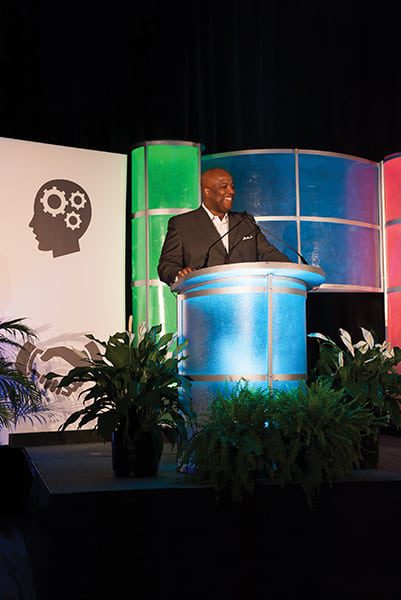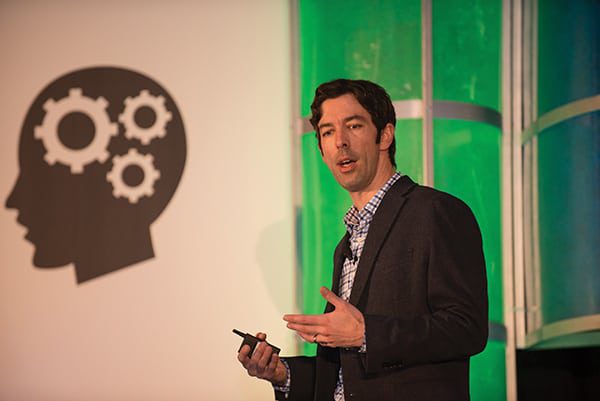Lessons in Resiliency and Risk
Keynote presentations at ELECTRIC POWER 2014 focused on new threats to power generators that range from climate change to a business environment that includes increasing numbers of large customer-generators. The takeaway: Traditional utilities can survive the new challenges, but only if they are prepared and flexible.
Climate change is changing the odds of extreme weather events, Entergy’s Rod West told the audience at the opening keynote session of ELECTRIC POWER 2014. West, who serves as Entergy’s executive vice president and chief administrative officer, led the team responsible for the $250 million reconstruction of New Orleans’ electrical infrastructure after Hurricane Katrina.
Though this year’s conference and exhibition began on Apr. 1 in New Orleans, West’s comments were no April Fool’s joke. Entergy, which operates as a traditional utility in the South and a merchant generator in the North, owns and operates about 30 GW of capacity, including 10 GW of nuclear power. Though one might think its Gulf Coast assets’ vulnerability to hurricanes would be the most significant weather-related threat, West noted that Entergy assets in all areas have been hit by extreme weather.
Prepare, Harden, and Engage
“We understand storms,” West (Figure 1) asserted as he delivered his keynote on risk and resiliency for power companies.
 |
| 1. Rod West. Entergy’s executive vice president and chief administrative officer delivered the first of two keynote addresses at ELECTRIC POWER 2014 in New Orleans. Courtesy: POWER |
Not only is climate change increasing the odds of extreme weather events, but the losses from those events are also increasing, he explained. West acknowledged that, “often to the chagrin of our colleagues,” Entergy has been at the forefront of addressing the implications of climate change. It also has moved away from an all-or-nothing discussion of climate change. Instead, “it’s a conversation about managing risk.”
To that end, in 2004 the company engaged with a team of consultants and other Gulf Coast entities to develop “a fact-based assessment of risk” to the U.S. Gulf Coast. One key finding: The Gulf Coast faces expected cumulative losses over $350 billion by 2030 as a result of environmental risks. Even events not directly “caused” by climate change are exacerbated by it.
If you are affected by climate change impacts, he said, it’s just loss, whether you “believe” in climate change or not. The conversation Entergy has is about resilience. But it’s not just about hardening infrastructure.
Though hurricanes are some of the most dramatic and destructive weather events, the largest cumulative destruction is caused by thunderstorms, high wind, tornados, and winter storms, which means all regions are vulnerable.
Resilience isn’t just a concern for the Gulf Coast, as the East Coast learned during Hurricane Sandy. West suggested that after seeing the devastation that Sandy wrought, it became more obvious that planning, preventing, and restoring service after extreme weather events is a national priority that requires three actions: prepare, harden, and engage.
West spent some time detailing the importance of engaging utility customers in these steps. Because restoration of electricity service can take weeks after a major event, customers—industrial, commercial, and residential—may need to be prepared for long outages or have backup plans.
The costs of inaction surpass those of investment in preparation and hardening, West argued. One of the approaches Entergy and the State of Louisiana have taken is familiar to the nuclear industry: defense in depth. The elements of that strategy include, but are not limited to, building and maintenance of levees and coastal wetlands.
Coastal wetlands are an important component of that defense-in-depth strategy because, as West underscored, it’s not just a “tree-hugger” issue. The loss of coastal wetlands affects energy industries all along the Gulf and has additional economic impact. Especially given the importance of the energy and related industries to the Gulf Coast region, the State of Louisiana has developed a plan to reverse the loss of coastal wetlands known as the “Gulf Coast Adaptation Study.”
Entergy’s approach appears to be paying off. West noted that as a result of efforts the company has made, outage restoration after Hurricane Isaac was faster than for the previous several storms: Ike, Gustav, Rita, and Katrina.
When Large Customers Become Large Generators
Brian Janous (Figure 2), director of energy strategy for Microsoft, made the second keynote presentation. As is the case with many other large technology companies, including Google and Apple, Microsoft is committed to providing much of its own power, including carbon-free electricity.
To help explain why Microsoft has gone so deeply into the business of developing generation, Janous said that the company looks at data as a form of energy. Energy is used to produce electricity, which is distributed as data. In one slide, Janous demonstrated all the points at which energy is lost, from power plant to transmission to end use at a data center. By the time you reach the server, 99% of the energy is lost, according to Microsoft’s analysis. By bringing energy production to its data centers, Janous explained, Microsoft can reduce overall losses and optimize the energy supply chain.
In fact, Microsoft is doing more than setting up generation “outside the fence” of its data centers. In collaboration with the University of California, Irvine, it’s developing an in-rack fuel cell process that puts generation and end-use equipment—servers—side by side on racks. In February this year, the company ran a successful demonstration that Microsoft said boosted the electrical efficiency of its fuel cell system from 39.8% to 53.3% “by cutting out much of the electrical conditioning systems.” It also cuts out transmission losses.
The company announcement of the test claims that, “If this approach were scaled up across the United States, we anticipate that fuel cell stacks—in which the fuel cell is integrated directly into the server rack—could double energy efficiency while cutting out numerous points of failure that occur in traditional electrical transmission.”
Beyond onsite generation, the company is also investing in renewable generation sited elsewhere—its first such agreement is a 20-year power purchase deal from a 110-MW wind farm to be developed near Dallas—and feeding it to the grid because the company has a policy of being carbon neutral. In fact, it even has a corporate-wide price on carbon that easily justifies these capital expenditures.
Distributed and Centralized Are Not the Only Options
The argument made by many that traditional centralized power generation will be supplanted by distributed generation (DG)—thereby constituting a cataclysmic “disruption” of the power industry—wasn’t one made by Janous, to the likely surprise of many listening. In fact, he pointed to “Silicon Valley” as the source of much of the hype about DG overthrowing traditional utilities (Microsoft is headquartered more than 800 miles north of Silicon Valley, in Redmond, Wash.).
Janous argued that the future will be neither solely centralized nor distributed. “The future is integrated,” he predicted. And data (an unsurprising claim from the likes of a tech company) will be the enabling factor to integrate distributed and centralized generation. In that new, integrated world, Janous sees utilities delivering different types of services, including networked refrigerators and energy storage.
What if utilities aren’t interested in new business models? Whether they encourage DG or not, Janous said, “it will happen.” That said, Silicon Valley tech companies underestimate the barriers to disrupting the traditional utility infrastructure, he said.
It appears that even behemoths like Microsoft see value in the interconnected grid. As an example of how utilities might play in the new world, he suggested that diesel generators currently used as backup for data centers could represent an opportunity for utilities to be involved in site-based generation—presumably if they could dispatch it or possibly even own and lease those distributed power plants.
Though most companies don’t look at energy beyond the next few years, Janous said Microsoft is making a long-term commitment to it. Of course, the company founded by the now-richest man in the world has more opportunities to do this than the average enterprise, but that doesn’t make it an anomaly. ■
— Gail Reitenbach, PhD is POWER’s editor (@GailReit, @POWERmagazine).
